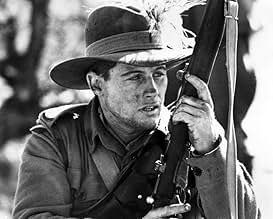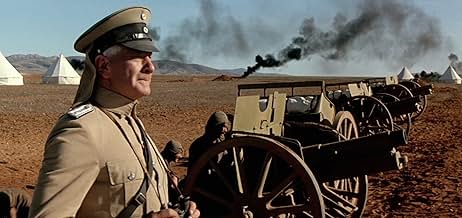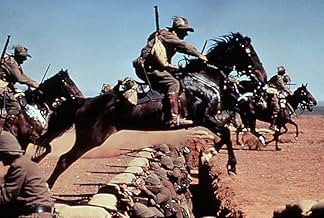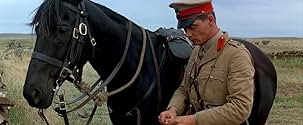NOTE IMDb
6,8/10
2,2 k
MA NOTE
Ajouter une intrigue dans votre langueIn 1917 when the British forces are bogged down in front of the Turkish and German lines in Palestine they rely on the Australian light horse regiment to break the deadlock.In 1917 when the British forces are bogged down in front of the Turkish and German lines in Palestine they rely on the Australian light horse regiment to break the deadlock.In 1917 when the British forces are bogged down in front of the Turkish and German lines in Palestine they rely on the Australian light horse regiment to break the deadlock.
- Réalisation
- Scénario
- Casting principal
- Récompenses
- 2 victoires et 1 nomination au total
Jack Heywood
- Dave's Dad
- (as John Heywood)
Avis à la une
This impressive flick is based on a true story and most of the characters in the film were based on real people and dealing with the continued coming of age of the Australian nation and its soldiers . The film follows Four Australians, Frank (Gary Sweet), Scotty (Jon Blake who was injured in a car accident and he suffered permanent paralysis and brain damage until his recent death) an Irish-Australian, Chiller (Tim McKenzie) and Tas (John Walton) in Palestine in 1917, part of the 4th Light Horse Brigade of the British and Commonwealth Dominion forces. When Frank is wounded and dies of his wounds, he is replaced by Dave (Peter Phelps). Dave finds himself unable to fire his weapon in combat and is transferred to the Medical Corps, where he will not need to carry a weapon, but where he will still be exposed to the fighting . After the Second Battle of Gaza ended in complete failure, General Archibald Murray (Tony Bonner) , the commander in chief of the British forces in Egypt and Palestine, was replaced by the distinguished cavalry commander, General Edmund Allenby (Anthony Hawkins) , formerly the commander of the British Third Army on the Western Front to carry out the British plan the capture of Beersheba. During an attack by Turkish cavalry, Major Richard Meinertzhagen (Anthony Andrews) deliberately leaves behind documents indicating that the attack on Beersheba will only be a diversion. At the ending there takes place the Battle of Beersheba (Turkish: Birüssebi Savaşı) that was one critical element of a wider British offensive, known as the Third Battle of Gaza, aimed at breaking the Ottoman defensive line that stretched from Gaza on the Mediterranean shore to Beersheba ; it took place on 31 October 1917, as part of the Sinai and Palestine campaign during World War I . Notable was the charge of the Australian 4th Light Horse Brigade, which covered some 6 kilometres (3.7 mi) to overrun and capture the last remaining Ottoman trenches, and secure the surviving wells at Birüssebi . The total losses incurred by the Desert Mounted Corps was 53 men killed and 144 wounded. The heaviest Allied losses were suffered by the British infantry of XX Corps, which lost 116 killed in action, although the total number of men killed during the battle from the British force was far greater, totalling 171 men.
It follows in the wake of other Australian New Wave war movies such as Breaker Morant (1980), Gallipoli (1981), and the 5-part TV series Anzacs (1985). Recurring issues of these films include the Australian identity , such as mateship and friendship , ANZAC spirit , the loss of innocence in war, and breathtaking battles spectacularly filmed . Acceptable acting from main and support cast including prestigious Aussie/English actors such as Anthony Andrews , Shane Bryant , Sigrid Thornton , Tony Bonner , Gary Tweed , Bill Kerr , though none of the performances are really bad, but none are very good . Gorgeous outdoors are well photographed by cameraman Dan Cundey . Despite being set in Palestine and Egypt, the film was shot entirely on location in Victoria and Hawker, South Australia . Rousing and emotive musical score was composed by Mario Millo. It was nominated for Best Achievement in Cinematography and won an Australian Film Institute award in 1988 for Best Original Music Score and another for Best Achievement in Sound. It grossed a lot of money at the box office in Australia . Sensational directorial by the notorious filmmaker Simon Wincer, a Western expert, as he emigrated Hollywood and subsequently directed to Tom Selleck in ¨Monte Walsh¨ , ¨Crossfire trail¨ and ¨Quigley Down Under¨ to Paul Hogan in ¨Relampago Jack¨ and ¨Cocodrile Dundee in L.A.¨ and usually directs episodes for TV mini-series, such as ¨Into the West¨, ¨The Ponderosa¨ , ¨Lonesome Dove¨ and ¨The adventures of young Indiana Jones¨ , among others . Rating: good for the sensitive direction and proficient film-making ; the result is a sort of pacifist-aggressive war adventure . Worthwhile watching .
It follows in the wake of other Australian New Wave war movies such as Breaker Morant (1980), Gallipoli (1981), and the 5-part TV series Anzacs (1985). Recurring issues of these films include the Australian identity , such as mateship and friendship , ANZAC spirit , the loss of innocence in war, and breathtaking battles spectacularly filmed . Acceptable acting from main and support cast including prestigious Aussie/English actors such as Anthony Andrews , Shane Bryant , Sigrid Thornton , Tony Bonner , Gary Tweed , Bill Kerr , though none of the performances are really bad, but none are very good . Gorgeous outdoors are well photographed by cameraman Dan Cundey . Despite being set in Palestine and Egypt, the film was shot entirely on location in Victoria and Hawker, South Australia . Rousing and emotive musical score was composed by Mario Millo. It was nominated for Best Achievement in Cinematography and won an Australian Film Institute award in 1988 for Best Original Music Score and another for Best Achievement in Sound. It grossed a lot of money at the box office in Australia . Sensational directorial by the notorious filmmaker Simon Wincer, a Western expert, as he emigrated Hollywood and subsequently directed to Tom Selleck in ¨Monte Walsh¨ , ¨Crossfire trail¨ and ¨Quigley Down Under¨ to Paul Hogan in ¨Relampago Jack¨ and ¨Cocodrile Dundee in L.A.¨ and usually directs episodes for TV mini-series, such as ¨Into the West¨, ¨The Ponderosa¨ , ¨Lonesome Dove¨ and ¨The adventures of young Indiana Jones¨ , among others . Rating: good for the sensitive direction and proficient film-making ; the result is a sort of pacifist-aggressive war adventure . Worthwhile watching .
This is a story about some episode British-Turk campaign in Palestine in 1917. Very important role in this campaign was played by Australian forces. The key to conquer the Holy Land is city of Gaza. British general wants however to throw his forces to bypass the city and capture another one - Beersheba. To take them both it is necessary to keep his plan secret.
As a person who is interested in all WWI history I was waiting for this movie. I find it very good. All equipment seems to be very accurate, however, I've never heard about use of tanks in this front. There is a nice scene of air attack by German biplane, cars from that times, uniforms, and so on -- it all seems to be historical correct. The final charge is worth waiting for. I think that anyone who is interested in this campaign would be satisfied.
Because of Australian point of view the role of British army seems to be a little underrated. I especially mean British commander -- general Allenby. I think it would be good to say at the very end that after capturing Beersheba, Gaza fell as well a week later, and the road to Jerusalem was opened. This was what was lacking for me.
As a person who is interested in all WWI history I was waiting for this movie. I find it very good. All equipment seems to be very accurate, however, I've never heard about use of tanks in this front. There is a nice scene of air attack by German biplane, cars from that times, uniforms, and so on -- it all seems to be historical correct. The final charge is worth waiting for. I think that anyone who is interested in this campaign would be satisfied.
Because of Australian point of view the role of British army seems to be a little underrated. I especially mean British commander -- general Allenby. I think it would be good to say at the very end that after capturing Beersheba, Gaza fell as well a week later, and the road to Jerusalem was opened. This was what was lacking for me.
I saw only the last half of this one, appropriately enough on Anzac Day, tuning in just as the delicious Nurse Siggy Thornton is writing a love letter that intelligence Major Anthony Andrews is going to mislead Johnny Turk with. So I missed the alleged tedium of the first hour. The film is no doubt best viewed on a big screen, but what I did see in the last hour was the Australian Light Horse attack on Beersheba, brilliantly staged and filmed, with hundreds of horses and extras and tonnes of dramatic tension.
The actual battle was an Aussie military success, due in large part to their opponents, especially the Germans, underestimating them. It was a change from Gallipoli, where some of the horsemen had fought a couple of years earlier. It was terribly thoughtful of the Australian commanders to order the attack an hour before sunset when the light is best, and Dean Semler the cinemaphotographer takes full advantage of it. The close camera shots in the battle really give you the feeling you're right in it - there is nothing particularly original about "Saving Private Ryan" made 10 years later.
Yes, it's a cliché-ridden and chauvinistic script. The real villains are the Germans, all from Central Casting's Nazi division, despite this being a movie about the FIRST World War, but the British officers are also portrayed as pretty perfidious - the guys who made snobbery an art form to cover their incompetence. The Turks, though, are shown as brave and worthy opponents, if a little under the Germans' thumb. No doubt John Ford would have done it differently (I'm not sure he would have handled the horses any better) but this is the Australian point of view. A Turkish version would be interesting.
Anyway, worth it for the final battle.
The actual battle was an Aussie military success, due in large part to their opponents, especially the Germans, underestimating them. It was a change from Gallipoli, where some of the horsemen had fought a couple of years earlier. It was terribly thoughtful of the Australian commanders to order the attack an hour before sunset when the light is best, and Dean Semler the cinemaphotographer takes full advantage of it. The close camera shots in the battle really give you the feeling you're right in it - there is nothing particularly original about "Saving Private Ryan" made 10 years later.
Yes, it's a cliché-ridden and chauvinistic script. The real villains are the Germans, all from Central Casting's Nazi division, despite this being a movie about the FIRST World War, but the British officers are also portrayed as pretty perfidious - the guys who made snobbery an art form to cover their incompetence. The Turks, though, are shown as brave and worthy opponents, if a little under the Germans' thumb. No doubt John Ford would have done it differently (I'm not sure he would have handled the horses any better) but this is the Australian point of view. A Turkish version would be interesting.
Anyway, worth it for the final battle.
A First World War Australian cavalry -- sorry, mounted infantry -- film set in the Holy Land, that's not something one tends to see every day. So, for me, the fact that, yes, the characters and situations can be a little clichéd at times is far outweighed by the novelty of the whole scenario. Quibbles are easy to put to one side.
The cavalry distinction is important. Cavalry would be armed with carbines and sabres. Mounted infantry have rifles and dismount in order to fight. This subtlety plays a part in the outcome.
A series of small skirmishes heightens tension within the film until the exciting finale, when there is a fantastic, large scale, cav ... mounted infantry charge which got my pulse racing. You'll recall something similar in David Lean's "Lawrence of Arabia". This set piece is bigger. Johnny Turk was the villain that time too.
This being an Australian Imperial Force meets the British Army sort of film, there is bound to be a little Pommy-bashing going 'round. When I lived briefly in Australia a decade ago, I found Pommy-bashing to be the single unattractive facet to the Australian national character. (The Kiwis don't do it. We like Poms here too. Pity the Dominions can't agree on that one.) So while some of the Poms in this film might be a few sheep short of a paddock, still there *is* balance, with one Pom who is much cleverer than the average. Bashing even works its way into the plot, a nice touch that.
The film does not use an excessive amount of Strine lingo -- billy, tucker -- so very little acclimatization is necessary for the uninitiated.
I can't vouch for the overall authenticity of this film. But I did notice that campaign map in the Turkish commander's office. It's labelled in Arabic only. Egypt is identified as "Misr". Geez, that is the correct Arabic name. And the Ottomans were still using the Arabic alphabet at the time. (It's Atatürk after the war who switched Turkish over to the Roman alphabet.) The thing's fair dinkum, mate. If they cared enough to get details like that right, then I'm sure that says a lot about the effort put into the film as a whole.
There is an earlier Australian film about the Light Horse I'd like to see, "Forty Thousand Horsemen" from 1940 or '41 (sources differ). Finding a copy of that film in this hemisphere though would be extraordinary, a bit like finding a North American who likes Vegemite.
The cavalry distinction is important. Cavalry would be armed with carbines and sabres. Mounted infantry have rifles and dismount in order to fight. This subtlety plays a part in the outcome.
A series of small skirmishes heightens tension within the film until the exciting finale, when there is a fantastic, large scale, cav ... mounted infantry charge which got my pulse racing. You'll recall something similar in David Lean's "Lawrence of Arabia". This set piece is bigger. Johnny Turk was the villain that time too.
This being an Australian Imperial Force meets the British Army sort of film, there is bound to be a little Pommy-bashing going 'round. When I lived briefly in Australia a decade ago, I found Pommy-bashing to be the single unattractive facet to the Australian national character. (The Kiwis don't do it. We like Poms here too. Pity the Dominions can't agree on that one.) So while some of the Poms in this film might be a few sheep short of a paddock, still there *is* balance, with one Pom who is much cleverer than the average. Bashing even works its way into the plot, a nice touch that.
The film does not use an excessive amount of Strine lingo -- billy, tucker -- so very little acclimatization is necessary for the uninitiated.
I can't vouch for the overall authenticity of this film. But I did notice that campaign map in the Turkish commander's office. It's labelled in Arabic only. Egypt is identified as "Misr". Geez, that is the correct Arabic name. And the Ottomans were still using the Arabic alphabet at the time. (It's Atatürk after the war who switched Turkish over to the Roman alphabet.) The thing's fair dinkum, mate. If they cared enough to get details like that right, then I'm sure that says a lot about the effort put into the film as a whole.
There is an earlier Australian film about the Light Horse I'd like to see, "Forty Thousand Horsemen" from 1940 or '41 (sources differ). Finding a copy of that film in this hemisphere though would be extraordinary, a bit like finding a North American who likes Vegemite.
Historically accurate and meticulously researched, this is one of the genre of "federation-era" war productions in the 1980's by the Australian film industry. The high-quality movies and mini-series of this collection included such titles as "Breaker Morant", "Gallipoli" and "ANZACS", and one can see obvious similarities in the techniques and methodology used in their production. This, however, does not detract from their appeal or their entertainment value; quite the reverse, in fact. The formula for this genre was to take an historically-documented campaign and translate it as faithfully as possible to the big screen, with emphasis on characterisation, accuracy of detail and background.
The formula works, because the characters are believable, and the situations, events and settings have been faithfully re-created. Much of the background and information for this genre came from personal diaries and military archives preserved over the years, which adds credence to the plots, the action and the stories.
"The Lighthorsemen" highlights the campaign of the Australian mounted rifles in the North Africa battleground of the Great War, and culminates with the last successful action of horse-riding troops in combat. Without giving away the story too much, the taking of Beersheba in the closing days of 1918 was a decisive event in military history, and the screen portrayal of this action will have you on the edge of your seat.
Masterful performances by Jon Blake, Shane Briant and Bill Kerr (all veterans of this movie formula,) the attention to detail, the drama, and the occasional humour make for a very entertaining movie. It's recommended viewing.
The formula works, because the characters are believable, and the situations, events and settings have been faithfully re-created. Much of the background and information for this genre came from personal diaries and military archives preserved over the years, which adds credence to the plots, the action and the stories.
"The Lighthorsemen" highlights the campaign of the Australian mounted rifles in the North Africa battleground of the Great War, and culminates with the last successful action of horse-riding troops in combat. Without giving away the story too much, the taking of Beersheba in the closing days of 1918 was a decisive event in military history, and the screen portrayal of this action will have you on the edge of your seat.
Masterful performances by Jon Blake, Shane Briant and Bill Kerr (all veterans of this movie formula,) the attention to detail, the drama, and the occasional humour make for a very entertaining movie. It's recommended viewing.
Le saviez-vous
- AnecdotesWebsite Cinephilia reports of the Jon Blake accident and legal case: "Jon Blake was critically injured whilst driving home on December 1, 1986, after the final day's filming of La chevauchée de feu (1987). He sustained severe brain injuries and in December, 1995, the New South Wales Supreme Court ruled that Blake should be compensated for the loss of potential earnings as a star in the United States. After taking evidence from actors, directors, and film critics who indicated his career could have been as big as Mel Gibson's, the court awarded him $32 million in damages. This was later reduced to $7 million after the defence appealed."
- GaffesAt the rest camp just after the 2 soldiers pass the British Major and addresses the Colonel about the men wearing shorts at the end the Colonel calls the Major 'Sir', this wouldn't happen as a Colonel is a higher rank to Major.
- Versions alternativesUK versions are cut by 6 secs to remove cruel horsefalls.
- ConnexionsEdited into Les aventures du jeune Indiana Jones: Palestine, October 1917 (1993)
- Bandes originalesAUSTRALIA WILL BE THERE
Music and lyrics by W.W. 'Skipper' Francis
By Arrangement with Allans Music (Australia) Pty. Limited
Meilleurs choix
Connectez-vous pour évaluer et suivre la liste de favoris afin de recevoir des recommandations personnalisées
- How long is The Lighthorsemen?Alimenté par Alexa
Détails
- Date de sortie
- Pays d’origine
- Sites officiels
- Langue
- Aussi connu sous le nom de
- The Lighthorsemen
- Lieux de tournage
- St. Kilda, Melbourne, Victoria, Australia(beach, Mediterranean Sea)
- Sociétés de production
- Voir plus de crédits d'entreprise sur IMDbPro
Box-office
- Budget
- 10 500 000 $AU (estimé)
- Montant brut aux États-Unis et au Canada
- 33 779 $US
- Week-end de sortie aux États-Unis et au Canada
- 23 645 $US
- 10 avr. 1988
- Montant brut mondial
- 34 514 $US
- Durée
- 2h 11min(131 min)
- Mixage
- Rapport de forme
- 2.35 : 1
Contribuer à cette page
Suggérer une modification ou ajouter du contenu manquant




























